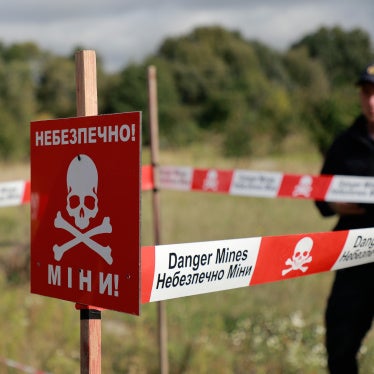Thank you for the floor, Madam Chair.
Human Rights Watch has two priorities for the Fifth Review Conference of the Convention on Conventional Weapons (CCW): lethal autonomous weapons systems and incendiary weapons.
In regard to lethal autonomous weapons systems, also known as fully autonomous weapons systems and, outside of this room, as killer robots, the Fifth Review Conference is an opportunity to make a real difference in global arms control and disarmament, to make a real difference in the protection of civilians—and the protection of soldiers. It is an opportunity to show the relevance and the importance of the CCW.
Indeed, the CCW has never tackled an issue with such potentially far-reaching consequences. Because we are not just trying to regulate or even ban a specific weapon, we are attempting to deal with a potential change in the very nature of warfare—a change that would not be for the betterment of humankind.
Human Rights Watch is a founder of the Campaign to Stop Killer Robots and Mary Wareham of Human Rights Watch serves as the Campaign’s global coordinator. The Campaign is calling for a preemptive prohibition, and we would like to see that prohibition take the form of a new Protocol VI to the CCW.
We appreciate the valuable work of Ambassador Biontino and others in the CCW discussions on lethal autonomous weapons systems to date. And we were very pleased that recommendations on the way forward were agreed to in the April meeting. We in particular view the recommendation to create an open-ended Group of Governmental Experts to undertake formal work as crucially important. We have expressed our hope that this is the CCW moving from talk to action.
But the High Contracting Parties need to be much more ambitious as they move forward. The weakest part of the recommendations is that the GGE is only supposed to come up with “options” for future work. In truth, we all already know what the options are, and we could put them on paper in an hour or two.
The CCW was commended for taking up this issue so quickly, but it has now fallen behind the curve as technology races forward. The main public takeaway, the lead story, from the April meeting was the lack of ambition by the High Contracting Parties and the “go slow” approach. Highly regarded and experienced officials like Michael Moller (the head of the UN Office in Geneva) and Angela Kane (former head of the UN Office of Disarmament Affairs) lamented the glacial pace of the work and the inadequacy of such an approach to this issue.
We urge High Contracting Parties to set aside four weeks for dedicated work on lethal autonomous weapons systems in 2017. This would not be unusual for the CCW. Indeed it would be standard practice when the CCW begins to take an issue seriously. We urge you to use those four weeks as a pre-negotiations phase, so that High Contracting Parties will be in a position to begin formal negotiations in 2018, with a view to concluding those negotiations in one or two years.
We of course believe those negotiations should be aimed at a preemptive prohibition on the development, production, and use of fully autonomous weapons systems – or an obligation to have meaningful human control over key combat functions, particularly targeting and kill decisions, in each individual attack.
It is worth noting that in June, we had the latest example of the scientific community supporting a ban, when Google DeepMind called for a preemptive ban treaty in testimony to the UK Parliament.
And just last week we had the latest example of the military supporting a prohibition, when United States General Paul Selva, the Vice-Chairman of the Joint Chiefs of Staff, the second highest ranking uniformed officer in the US, expressed support for a treaty against the creation of fully autonomous weapons systems. He referred to keeping human control over the final decision to use weaponry “a fairly bright line that we’re not willing to cross.”
Turning now to incendiary weapons, the current context in which we are discussing this is the reality of near daily incendiary weapons attacks in civilian areas in Syria, carried out by the joint Syrian-Russian military operation.
In nine weeks in June-August 2016 alone, Human Rights Watch recorded at least 18 incendiary weapons attacks in Syria, which it attributed to the joint Syrian-Russian operation. The actual number of attacks is likely far higher, as we are unable to independently confirm many reports.
States should condemn the use of air-dropped incendiary weapons in civilian areas of Syria, in apparent violation of Protocol III. They should also conduct a rigorous review of the adequacy of the Protocol III and address the inadequacies that have failed to prevent civilian harm from incendiary weapons.
At the Fifth Review Conference in December 2016, CCW High Contracting Parties should adopt a new mandate on incendiary weapons that sets aside time in 2017 to discuss the implementation and adequacy of Protocol III.
The most pressing changes needed to the Protocol are that the use of incendiary weapons should be prohibited within or near concentrations of civilians under all circumstances, regardless of whether the weapons are dropped from the air or launched from the ground, and that there should be an effects-based definition of incendiary weapons that encompasses multipurpose munitions, such as white phosphorus, based on their substantial incendiary effects rather than the purpose for which they are “primarily designed.” A comprehensive ban on the weapons would have the most far-reaching humanitarian benefits.
Finally, Human Rights Watch would like to join the ICRC and Switzerland in calling for more vigorous monitoring of developments in laser weaponry to ensure that Protocol IV is not being compromised in any way.
Thank you.








